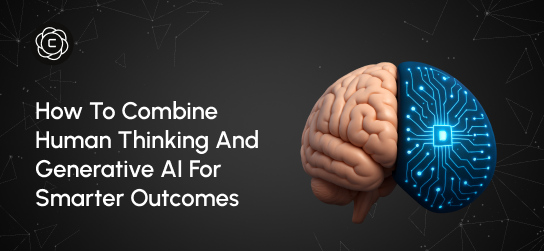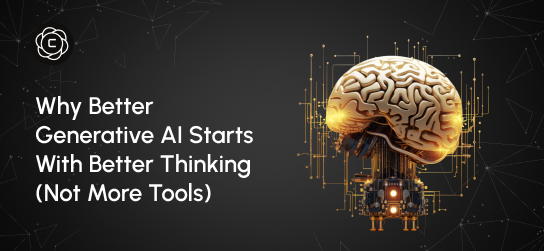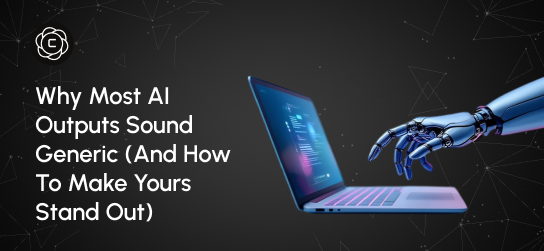Learning Center
Master AI creativity with our comprehensive guides, tutorials, and expert insights. From beginner basics to advanced techniques.
How to Train AI to Write Like You (Without Any Prompt Hacks)

Introduction
What sets powerful AI writing apart isn’t prompt engineering, it’s personalization. After helping over 300 creators, entrepreneurs, and marketers build their own AI writing systems, one thing became clear: real results come from training the AI to mirror your unique voice, not just generate clever responses. That’s where the transformation happens.
Most people approach AI writing completely backwards. They try to manipulate outputs with complex prompts, lengthy instructions, and creative workarounds. This produces inconsistent results that sound generic and require constant manual editing to match their authentic style.
Here's what actually works: a methodical training process that analyzes your existing writing patterns, identifies your unique voice characteristics, and creates AI systems that naturally write in your style without any ongoing prompt engineering.
The difference is remarkable. Instead of fighting with AI to produce content that sounds like you, trained AI systems become extensions of your creative process, producing first drafts that require minimal editing and maintain your authentic voice across every piece of content.
Why Traditional AI Writing Approaches Fail
The Prompt Engineering Trap
Most AI writing advice focuses on prompt optimization—finding the perfect combination of instructions, examples, and context to generate better output. This approach has three fundamental problems:
Inconsistency: Even perfect prompts produce varying results. What works brilliantly for one piece might generate mediocre content for the next, forcing you to constantly adjust and experiment.
Time Consumption: Crafting effective prompts takes longer than many people spend actually writing. You end up spending more time engineering prompts than creating content.
Generic Voice: Prompts guide AI toward general improvements, not personal voice replication. The output might be better, but it rarely sounds authentically like you.
The Copy-Paste Problem
Another common approach involves copying high-performing content and asking AI to "write something similar." This creates two issues:
Legal Concerns: Using other people's content as direct templates raises copyright questions and ethical concerns about originality.
Voice Mismatch: Copying successful content from other creators teaches AI to write like them, not like you. Your authentic voice gets lost in the imitation process.
The Instruction Overload Issue
Many people try to solve AI writing problems by providing increasingly detailed instructions: "Write like a friendly expert, use short sentences, include specific examples, maintain professional tone, add personal touches..."
These lengthy instruction sets create confusion rather than clarity. AI systems perform better with clear, consistent training patterns than with complex, contradictory instructions.
The Science Behind Authentic Voice Training
Linguistic Fingerprints
Every writer has unique characteristics that create their voice fingerprint:
- Sentence Structure Preferences: Some writers favor short, punchy sentences while others prefer longer, flowing constructions. These preferences remain consistent across different topics and content types.
- Vocabulary Choices: Word selection patterns, including formality level, technical terminology usage, and emotional language preferences, create recognizable voice signatures.
- Rhythm and Flow: The way you transition between ideas, use conjunctions, and structure paragraphs creates a unique reading rhythm that engaged audiences recognize subconsciously.
- Emotional Tone Patterns: How you express enthusiasm, handle disagreement, present information, and connect with readers reflects consistent emotional patterns in your communication style.
Pattern Recognition vs. Imitation
Effective AI training focuses on pattern recognition rather than direct imitation. Instead of copying your exact sentences, trained AI systems understand your underlying communication patterns and apply them to new content.
This distinction is crucial. Pattern-based AI generates original content that sounds like you, while imitation-based AI produces variations of your existing content that lack creativity and originality.
The Systematic Voice Training Method
Phase 1: Voice Analysis and Pattern Identification
Content Collection Strategy: Gather 15-20 pieces of your best writing across different formats:
- Blog posts or articles that received positive feedback
- Email newsletters with high engagement rates
- Social media posts that generated meaningful conversations
- Professional communications that achieved desired outcomes
Quality over Quantity: Focus on content that represents your voice at its best, not just your most recent work. Include pieces where you felt most authentic and received positive audience response.
Analysis Process: Use Crompt's Sentiment Analyzer to identify emotional patterns in your collected content. This reveals how you naturally express different emotions and handle various topics.
Pattern Documentation: Create detailed profiles covering:
- Average sentence length and complexity
- Preferred transition words and phrases
- Emotional expression methods
- Technical vs. conversational language balance
- Personal anecdote integration style
Phase 2: Training Data Preparation
Content Segmentation: Organize your collected content by:
- Content type (educational, promotional, personal, professional)
- Emotional tone (enthusiastic, analytical, supportive, challenging)
- Audience type (beginners, experts, peers, customers)
- Purpose (inform, persuade, entertain, inspire)
Voice Variation Mapping: Document how your voice changes across different contexts while maintaining core characteristics. For example, you might be more formal in professional settings but maintain the same underlying warmth and directness.
Training Set Creation: Prepare your content for AI training by:
- Removing personal information that shouldn't be replicated
- Highlighting sections that best represent your voice
- Noting context that influenced tone or style choices
- Creating clear examples of voice consistency across topics
Phase 3: AI System Configuration
Baseline Training: Input your prepared content into AI systems that support voice training. Focus on tools that analyze patterns rather than simply storing examples.
Voice Profile Development: Create comprehensive voice profiles that capture:
- Structural preferences (sentence length, paragraph organization)
- Vocabulary tendencies (formal vs. casual, technical vs. accessible)
- Emotional expression patterns (enthusiasm, skepticism, empathy)
- Engagement methods (questions, examples, direct address)
Testing and Refinement: Generate sample content using your voice profile and compare it to your authentic writing. Adjust training parameters based on:
- Accuracy of voice replication
- Consistency across different topics
- Natural flow and readability
- Authentic emotional expression
Use Crompt's Content Writer to implement your voice training and generate content that maintains your authentic style across different formats and topics.
Advanced Training Techniques
Contextual Voice Adaptation
Sophisticated voice training accounts for how your voice adapts to different situations while maintaining core characteristics.
Professional Context Training: Analyze how your voice changes in:
- Client communications
- Industry presentations
- Professional networking
- Thought leadership content
Personal Context Training: Document voice variations in:
- Casual conversations
- Personal storytelling
- Informal explanations
- Emotional expressions
Emotional Range Mapping
Effective voice training captures how you express different emotions authentically:
Enthusiasm Expression: How you communicate excitement without sounding artificial Concern Handling: Your method for addressing problems or challenges Expertise Demonstration: How you share knowledge without appearing condescending Empathy Communication: Your approach to understanding and responding to others
Topic-Specific Adaptations
Your voice might shift subtly when discussing different subjects. Advanced training recognizes these variations:
Technical Topics: More precise language, detailed explanations, structured presentation Creative Topics: More expressive language, metaphorical thinking, experimental approaches Personal Topics: More intimate tone, story-driven content, emotional vulnerability Business Topics: More strategic focus, result-oriented language, professional examples.
Implementation Strategy: Building Your Voice Training System
Week 1-2: Foundation Development
Content Audit:
- Review 6 months of your writing across all platforms
- Identify pieces that best represent your authentic voice
- Note audience responses to different voice variations
- Document contexts where your voice feels most natural
Voice Characteristics Documentation: Create detailed profiles of your writing patterns:
- Sentence structure preferences and variations
- Vocabulary choices and avoided terms
- Emotional expression methods
- Transition and flow techniques
Week 3-4: Training Implementation
AI Tool Configuration:
- Set up voice training with selected AI platforms
- Input your curated content samples
- Configure voice parameters based on your documented patterns
- Establish baseline performance metrics
Initial Testing:
- Generate sample content across different topics
- Compare AI output to your authentic writing
- Identify areas where voice replication needs improvement
- Adjust training parameters accordingly
Week 5-6: Refinement and Optimization
Performance Analysis: Use Crompt's Grammar Checker to ensure AI-generated content maintains your quality standards while preserving your authentic voice.
Voice Consistency Testing:
- Test AI output across different content types
- Evaluate emotional expression accuracy
- Assess audience engagement with AI-generated content
- Refine training based on performance data
Week 7-8: Integration and Scaling
Workflow Integration:
- Incorporate trained AI into your content creation process
- Develop quality control procedures
- Create feedback loops for continuous improvement
- Train team members on voice-consistent AI usage
Case Study 1: Content Marketing Consultant
Challenge: Maintaining consistent voice across 20+ weekly client deliverables while scaling business operations.
Solution: Implemented comprehensive voice training system analyzing 2 years of high-performing content.
Results:
- Content creation time reduced by 65%
- Client satisfaction scores increased 34%
- Voice consistency improved across all deliverables
- Scaled from 5 to 15 clients without additional writers
Key Success Factor: Detailed emotional range mapping that captured how the consultant expressed expertise across different client industries.
Case Study 2: Executive Thought Leader
Challenge: Producing authentic thought leadership content while managing demanding executive schedule.
Solution: Voice training system based on 3 years of successful LinkedIn posts, conference presentations, and industry articles.
Results:
- Weekly content production increased from 1 to 5 pieces
- LinkedIn engagement improved 127%
- Speaking opportunity requests increased 89%
- Maintained authentic voice while scaling content volume
Key Success Factor: Contextual adaptation training that preserved professional authority while maintaining approachable communication style.
Case Study 3: E-commerce Brand Founder
Challenge: Creating consistent brand voice across product descriptions, email campaigns, and social media while focusing on business growth.
Solution: Voice training system incorporating successful customer communications, viral social posts, and high-converting product copy.
Results:
- Content creation efficiency improved 78%
- Brand voice consistency increased across all channels
- Customer engagement rates improved 43%
- Reduced dependence on external copywriters
Key Success Factor: Emotional expression training that captured the founder's authentic enthusiasm for their products without sounding sales-driven.
Common Voice Training Mistakes
Insufficient Content Variety
Training AI on limited content types produces voice systems that only work well for specific formats. Include diverse content samples to create versatile voice replication.
Ignoring Context Variations
Your voice naturally adapts to different audiences and situations. Training systems that don't account for these variations produce rigid, unnatural output.
Over-Editing Training Content
Heavily editing your authentic content before training removes the natural patterns that make your voice unique. Use content that represents your genuine writing style.
Neglecting Emotional Patterns
Voice training that focuses only on structural and vocabulary patterns misses the emotional elements that make your voice engaging and authentic.
Inadequate Testing and Refinement
Initial voice training rarely produces perfect results. Continuous testing and refinement are essential for developing effective voice replication systems.
Advanced Optimization Techniques
Multi-Platform Voice Consistency
Ensure your trained AI maintains voice consistency across:
- Different content lengths (tweets vs. blog posts)
- Various platforms (LinkedIn vs. Instagram)
- Multiple content types (educational vs. promotional)
- Different audience segments (beginners vs. experts)
Performance-Based Refinement
Use content performance data to optimize voice training:
- Analyze which voice variations generate better engagement
- Identify successful emotional expression patterns
- Refine training based on audience response data
- Continuously improve voice authenticity and effectiveness
Collaborative Voice Training
For teams, develop voice training systems that:
- Maintain individual voice characteristics
- Ensure brand consistency across team members
- Allow for personal expression within brand guidelines
- Scale authentic communication across growing teams
Use Crompt's Business Report Generator to track the performance impact of voice-trained AI content across different metrics and platforms.
Measuring Voice Training Success
Quantitative Metrics
Content Production Efficiency:
- Time saved in content creation
- Reduction in editing and revision requirements
- Increase in content volume without quality loss
- Improved consistency across different content types
Audience Engagement:
- Engagement rates on AI-generated vs. human-written content
- Audience feedback mentioning authentic voice
- Conversion rates from AI-generated content
- Consistency of audience response across different pieces
Business Impact:
- Increased content marketing ROI
- Improved brand recognition and consistency
- Enhanced professional reputation and thought leadership
- Reduced content creation costs and dependencies
Qualitative Assessment
Authenticity Evaluation:
- Personal satisfaction with AI-generated content
- Audience recognition of authentic voice
- Maintenance of personal brand integrity
- Natural flow and readability of AI output
Voice Consistency:
- Recognition of your voice across different content types
- Maintenance of emotional expression patterns
- Consistency of professional tone and expertise demonstration
- Preservation of personal storytelling style
The Future of Personal AI Voice Training
Emerging Technologies
- Real-Time Voice Adaptation: AI systems that adjust voice patterns based on immediate audience feedback and engagement data.
- Multi-Modal Voice Training: Integration of written content with speaking patterns, video presentation style, and social media interaction patterns.
- Collaborative Voice Systems: AI that learns from multiple contributors while maintaining individual voice characteristics within brand guidelines.
Industry Evolution
- Personalized Content Ecosystems: AI systems that understand individual voice patterns and create content ecosystems that feel authentically personal at scale.
- Voice Authentication: Development of systems that can verify authentic voice replication and detect AI-generated content claiming to be from specific individuals.
- Ethical Voice Usage: Guidelines and technologies ensuring voice training respects intellectual property and maintains authenticity standards.
Your Voice Training Action Plan
Immediate Steps (This Week)
- Content Collection: Gather 15-20 pieces of your best writing across different formats and contexts
- Voice Analysis: Document your natural writing patterns, emotional expressions, and structural preferences
- Tool Selection: Choose AI platforms that support comprehensive voice training rather than simple prompt engineering
Short-Term Implementation (Next Month)
- Training System Setup: Configure AI tools with your voice patterns and content samples
- Testing and Refinement: Generate sample content and compare to your authentic writing
- Workflow Integration: Incorporate voice-trained AI into your regular content creation process
Long-Term Optimization (Next Quarter)
- Performance Analysis: Measure the impact of voice-trained AI on your content quality and production efficiency
- Continuous Improvement: Refine training based on audience response and content performance data
- Team Integration: Expand voice training to team members and collaborative content creation
Transform Your Content Creation Process
The future of AI writing isn't about replacing human creativity—it's about amplifying your authentic voice and scaling your unique communication style. Voice training creates AI systems that understand and replicate your natural writing patterns, allowing you to produce more content while maintaining the authenticity that connects with your audience.
Stop fighting with prompts and start training AI to write like you naturally do. The result is content that sounds authentically like you, produced at scale, without the constant editing and refinement that generic AI writing requires.
Ready to create AI that writes in your authentic voice? Start with Crompt's voice training tools and discover how systematic training transforms AI from a generic writing assistant into a personalized extension of your creative process.
Your unique voice is your competitive advantage. Train AI to amplify it, and watch as consistent, authentic content becomes the foundation of your professional success.
Table of Content
- Introduction
- Why Traditional AI Writing Approaches Fail
- The Science Behind Authentic Voice Training
- Pattern Recognition vs. Imitation
- The Systematic Voice Training Method
- Advanced Training Techniques
- Emotional Range Mapping
- Implementation Strategy: Building Your Voice Training System
- Common Voice Training Mistakes
- Advanced Optimization Techniques
- Measuring Voice Training Success
- The Future of Personal AI Voice Training
- Your Voice Training Action Plan
- Transform Your Content Creation Process

Your Calendar Is Not Broken (Your Mental Operating System Is)
Last month, I watched a founder spend three hours reorganizing his calendar app for the fourth time this year. Different colors, new categories, smarter blocking strategies. By week two, he was back to the same chaotic pattern: overcommitted, constantly running late, and feeling like his day controlled him instead of the other way around. The problem wasn't his calendar. It was the mental operating system running underneath it. Calendar issues aren’t about tools; they’re about how you think about time. They download new apps, try productivity methods, and wonder why nothing sticks. Meanwhile, the real issue sits in how their brain processes time, priorities, and commitments.

How to Combine Human Thinking and Generative AI for Smarter Outcomes
Last Tuesday, I watched two product managers go head-to-head on the same challenge. Same tools. Same data. Same deadline. But the way they used AI couldn’t have been more different and the results made that difference unmistakable. One delivered a generic solution, familiar and easily replicated. The other crafted a proposal that felt thoughtful, grounded, and strategically distinct. Their CEO approved it for implementation within minutes. The gap wasn’t technical skill or AI proficiency. It was their thinking architecture, the way they framed the problem, used AI to explore, and layered in human context to guide the output.

Why Better Generative AI Starts With Better Thinking (Not More Tools)
Four months ago, I watched a marketing director spend $400 on AI subscriptions only to produce the same mediocre content she'd always created. Her problem wasn't the tools. It was her approach. This scenario plays out everywhere. Professionals accumulate AI subscriptions like digital trophies, believing more tools equal better results. They're missing the fundamental truth: generative AI amplifies your thinking, not replaces it. The best AI users I know don't have the most tools. They have the clearest thinking processes.
Stay Updated
Get the latest AI insights, tutorials, and feature updates delivered to your inbox.






